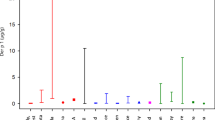Abstract
During the Minnesota Children's Pesticide Exposure Study (MNCPES), comparisons were made between the insecticide/herbicide loadings obtained with two household dust/insecticide or herbicide samplers: the Edwards and Lioy (EL) press sampler (used for dust collection from carpets or other surfaces) and the Lioy, Wainman and Weisel (LWW) surface wipe sampler. The results were compared with hand rinse levels, and urine metabolite levels obtained from 102 children (ages 3–13). All measurements were made during a 1-week sampling period, and information was obtained on household pesticide use and each child's activities. Of the homes, <5% had recent spot uses of a pesticide but none had recent general applications. The analyses focused primarily on atrazine (a herbicide), and malathion, diazinon, and chlorpyrifos (insecticides). Metabolites were measured for atrazine, malathion and chlorpyrifos. The atrazine levels obtained using the EL indicate that this compound was transported into the home by an unquantified transport mechanism (e.g. tracking of soil). Two malathion hand rinse values exceeded >170 ng/cm2, suggesting that since indoor surface levels were low, these children had other sources of exposure. Atrazine, chlorpyrifos and malathion were detectable in >30% of the homes by the EL, LWW or hand rinse. Only chlorpyrifos had detectable levels in ≥50% of the samples for all types, i.e. compound or metabolite, which is consistent with it being a common household pesticide. The median (and maximum) chlorpyrifos levels for the EL surface, EL carpet, LWW surface (two rooms), hand rinse, and urine metabolites were: 0.07 (32.6) ng/cm2; 0.07 (44.5) ng/cm2; 0.34 (3.64) ng/cm2; 0.42 (14.4) ng/cm2; 0.03 (2.14) ng/hand and 6.9 (59.0) µg/g, respectively. A strong correlation was found for chlorpyrifos between the EL surface and carpet samples. Chlorpyrifos levels detected by LWW had a different distribution and concentration range than the EL, indicating that it collected more than the surface dislodgeable insecticide. EL was directly comparable to the hand rinse or urine levels, but only the LWW had a weak correlation with hand rinse levels, suggesting that the children had other sources of chlorpyrifos exposure. Thus, mechanistic exposure studies are needed to more accurately establish exposure–dose relationships in residential settings.
This is a preview of subscription content, access via your institution
Access options
Subscribe to this journal
Receive 6 print issues and online access
$259.00 per year
only $43.17 per issue
Buy this article
- Purchase on Springer Link
- Instant access to full article PDF
Prices may be subject to local taxes which are calculated during checkout
Similar content being viewed by others
Author information
Authors and Affiliations
Rights and permissions
About this article
Cite this article
LIOY, P., EDWARDS, R., FREEMAN, N. et al. House dust levels of selected insecticides and a herbicide measured by the EL and LWW samplers and comparisons to hand rinses and urine metabolites. J Expo Sci Environ Epidemiol 10, 327–340 (2000). https://doi.org/10.1038/sj.jea.7500099
Accepted:
Published:
Issue Date:
DOI: https://doi.org/10.1038/sj.jea.7500099
This article is cited by
-
Toxicity, degradation and analysis of the herbicide atrazine
Environmental Chemistry Letters (2018)
-
Sampling scheme for pyrethroids on multiple surfaces on commercial aircrafts
Journal of Exposure Science & Environmental Epidemiology (2010)
-
Employing dynamical and chemical processes for contaminant mixtures outdoors to the indoor environment: The implications for total human exposure analysis and prevention
Journal of Exposure Science & Environmental Epidemiology (2006)
-
Video methods in the quantification of children's exposures
Journal of Exposure Science & Environmental Epidemiology (2006)
-
Exposures of preschool children to chlorpyrifos and its degradation product 3,5,6-trichloro-2-pyridinol in their everyday environments
Journal of Exposure Science & Environmental Epidemiology (2005)



